Introduction
Here are some examples of exercises for you to try. The exercises may be suggested for a condition or for rehabilitation. Start each exercise slowly. Ease off the exercises if you start to have pain.
You will be told when to start these exercises and which ones will work best for you.
How to do the exercises
Heel slide (ankles crossed)

slide 1 of 10
slide 1 of 10, Heel slide (ankles crossed),
- Lie on your back with your knees bent.
- Slide your heel back by bending your affected knee as far as you can. Then hook your other foot around your ankle to help pull your heel even farther back.
- Hold for about 6 seconds.
- Return to your starting position.
- Repeat 8 to 12 times.
- If you can, repeat these steps for your other knee.
Heel slide on a wall
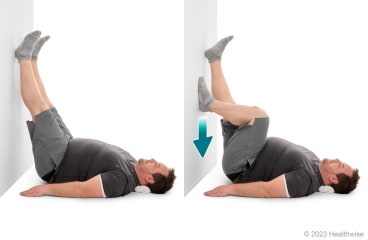
slide 2 of 10
slide 2 of 10, Heel slide on a wall,
- Lie on the floor close enough to a wall so that you can place both legs up on the wall. Your hips should be as close to the wall as is comfortable for you.
- Start with both feet resting on the wall. Slowly let the foot of your affected leg slide down the wall until you feel a stretch in your knee.
- Hold for 15 to 30 seconds.
- Then slowly slide your foot up to where you started.
- Repeat 2 to 4 times.
- It's a good idea to repeat these steps with your other leg.
Quad set

slide 3 of 10
slide 3 of 10, Quad set,
- Sit or lie down on a firm surface or the floor with your affected leg straight. Place a small, rolled-up towel under your knee.
- Tighten the thigh muscles of your straight leg by pressing the back of your knee down into the towel.
- Hold for about 6 seconds, then rest.
- Repeat 8 to 12 times.
- It's a good idea to repeat these steps with your other leg.
Short-arc quad
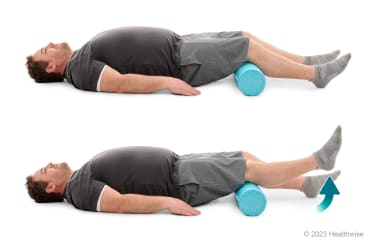
slide 4 of 10
slide 4 of 10, Short-arc quad,
- Lie on your back with your knees bent over a foam roll or a large rolled-up towel.
- Lift the lower part of your affected leg and straighten your knee by tightening your thigh muscle. Keep the back of your knee on the foam roll or rolled-up towel.
- Hold your knee straight for about 6 seconds. Then slowly bend your knee and lower your leg back to the floor.
- Repeat 8 to 12 times.
- It's a good idea to repeat these steps with your other leg.
Hip flexion (lying down, leg straight)
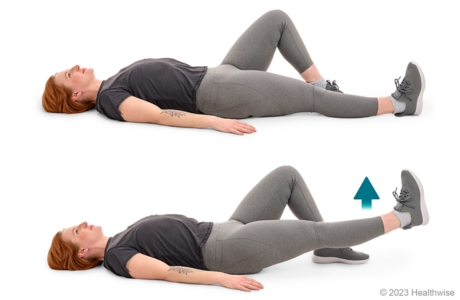
slide 5 of 10
slide 5 of 10, Hip flexion (lying down, leg straight),
- Lie on your back with your affected leg straight. You can bend your other leg, if that feels more comfortable.
- Tighten the thigh muscles in your affected leg by pressing the back of your knee down. Hold your knee straight.
- Keeping the thigh muscles tight and your leg straight, lift your affected leg up so that your heel is about 12 inches off the floor. Hold for about 6 seconds, then lower slowly.
- Repeat 8 to 12 times.
- It's a good idea to repeat these steps with your other leg.
Hamstring set (seated)
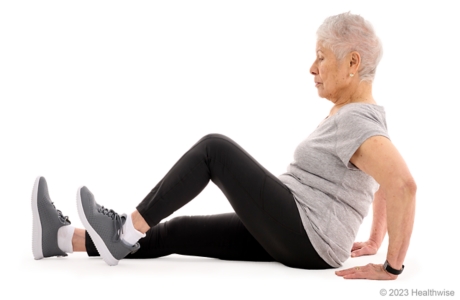
slide 6 of 10
slide 6 of 10, Hamstring set (seated),
- Sit with your affected leg bent. Your other leg should be straight and resting on the floor.
- Tighten the muscles on the back of your bent leg (hamstring) by pressing your heel into the floor.
- Hold for about 6 seconds, and then rest.
- Repeat 8 to 12 times.
- It's a good idea to repeat these steps with your other leg.
Hip adduction (seated)
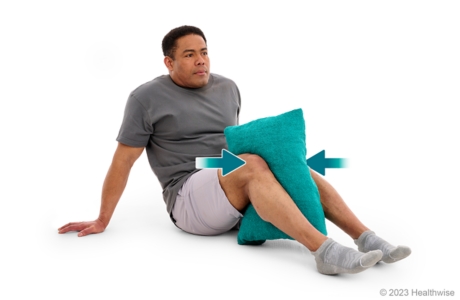
slide 7 of 10
slide 7 of 10, Hip adduction (seated),
- Sit on the floor with your knees bent.
- Place a pillow or a folded towel between your knees.
- Put your hands slightly behind your hips for support.
- Squeeze the pillow by tightening the muscles on the inside of your thighs.
- Hold for 6 seconds, then rest.
- Repeat 8 to 12 times.
Hip abduction (seated)
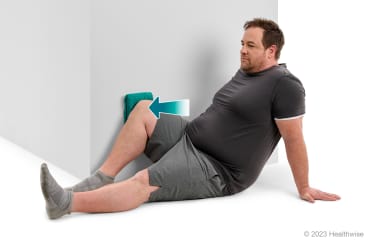
slide 8 of 10
slide 8 of 10, Hip abduction (seated),
- Sit on the floor with your affected leg close to a wall. Bend your affected leg and keep that foot on the floor.
- Place a pillow or folded towel between the outside of your knee and the wall.
- Put your hands slightly behind your hips for support.
- Push the outside of your knee against the pillow and the wall.
- Hold for 6 seconds, then rest.
- Repeat 8 to 12 times.
- It's a good idea to repeat these steps with your other leg.
Lateral step-up
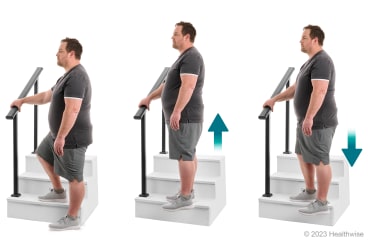
slide 9 of 10
slide 9 of 10, Lateral step-up,
- Stand sideways on the bottom step of a staircase with your affected leg on the step and your other foot on the floor.
- Keeping your head up and your back straight, lean slightly forward. Hold on to a handrail or wall if you feel unsteady.
- Use your affected leg to raise yourself up, bringing your other foot level with the stair step. Then slowly bend your knee to lower your foot back down. As you bend and straighten your leg:
- Repeat 8 to 12 times.
- It's a good idea to repeat these steps with your other leg.
- Keep your hips level.
- Keep your knee moving in a straight line with your middle toe. Don't let your knee go past your toe.
- Keep your heel flat on the step.
Wall squat with ball
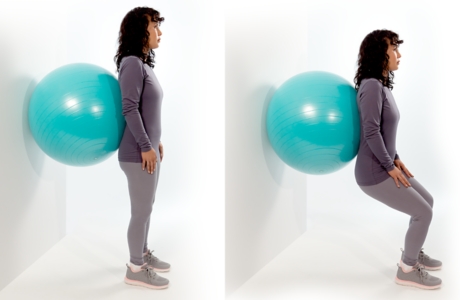
slide 10 of 10
slide 10 of 10, Wall squat with ball,
- Stand with your back facing a wall. Place your feet about shoulder-width apart.
- Place the exercise ball between your middle back and the wall. Move your feet out in front of you so they are about a foot in front of your hips. Tighten your belly muscles by pulling your belly button in toward your spine.
- Slowly squat down as if you are going to sit in a chair, rolling your back over the ball as you squat. The ball should move with you but stay pressed into the wall.
- Be sure that your knees do not go in front of your toes as you squat.
- Hold for about 6 seconds.
- Slowly rise to your standing position.
- Repeat 8 to 12 times.
Current as of: July 17, 2023
Author: Ignite Healthwise, LLC Staff
Clinical Review Board
All Healthwise education is reviewed by a team that includes physicians, nurses, advanced practitioners, registered dieticians, and other healthcare professionals.

